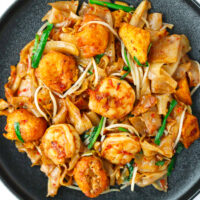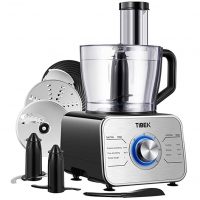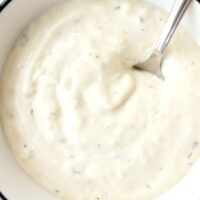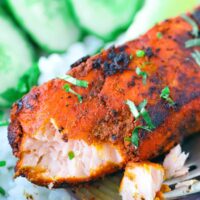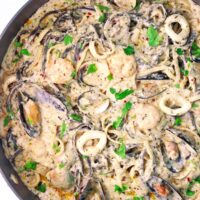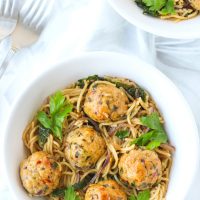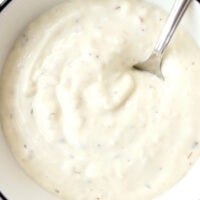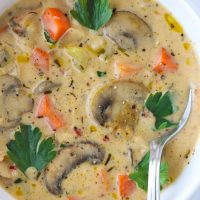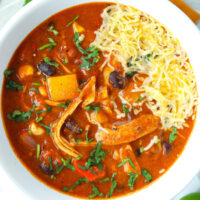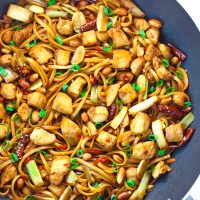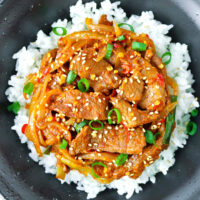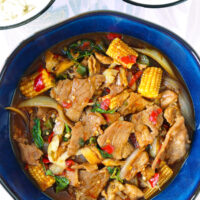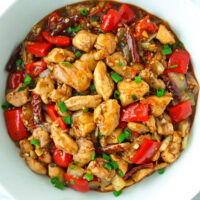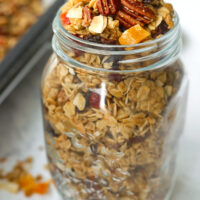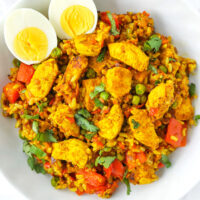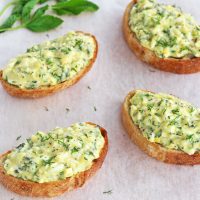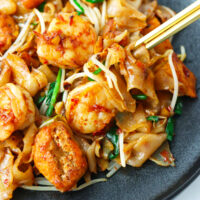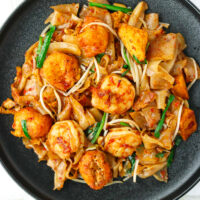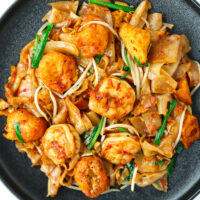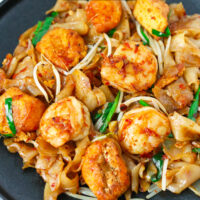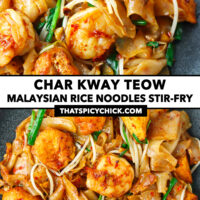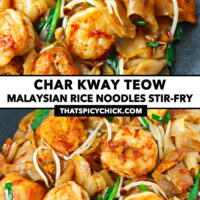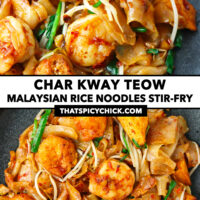Char Kway Teow (Malaysian Flat Wide Rice Noodles Stir-fry)
This post contains affiliate links.
Char Kway Teow is an incredibly DELICIOUS classic hawker street food rice noodles dish from Malaysia and Singapore! Charry, smoky flat wide rice noodles with shrimp, fish tofu, fried tofu puffs, scrambled egg, bean sprouts, and Chinese chives get wok fried in a savory-sweet sauce and spicy chili paste!
Char Kway Teow (also spelled sometimes as “Char Kuey Teow”) is a classic street food stir-fried rice noodles dish from Malaysia. It’s also very popular in Singapore, where you’ll find it in most hawker food centers.
This iconic dish comprises of beautifully charred and smoky fresh flat wide rice noodles, a savory-sweet sauce, a spicy chili paste for a bit of a kick, and an assortment of meat, seafood, and veggies. Depending on the region, different proteins and seafood will be used. However, blood cockles, Chinese dried sausage (‘lap cheong’), shrimp/prawns, and eggs are typically used in the Penang version from Malaysia.
In my version of Char Kway Teow, I like to use juicy jumbo shrimp, salty-sweet fish tofu (more on them below), and squishy fried tofu puffs for the proteins. However, you can totally customize this dish with whatever proteins you love and are easily accessible to you!
If you’re a fan of stir-fried rice noodle dishes, you might also like my chicken chow fun, pad see ew, pad kee mao gai (Thai drunken noodles with chicken), and Thai eggplant noodles.
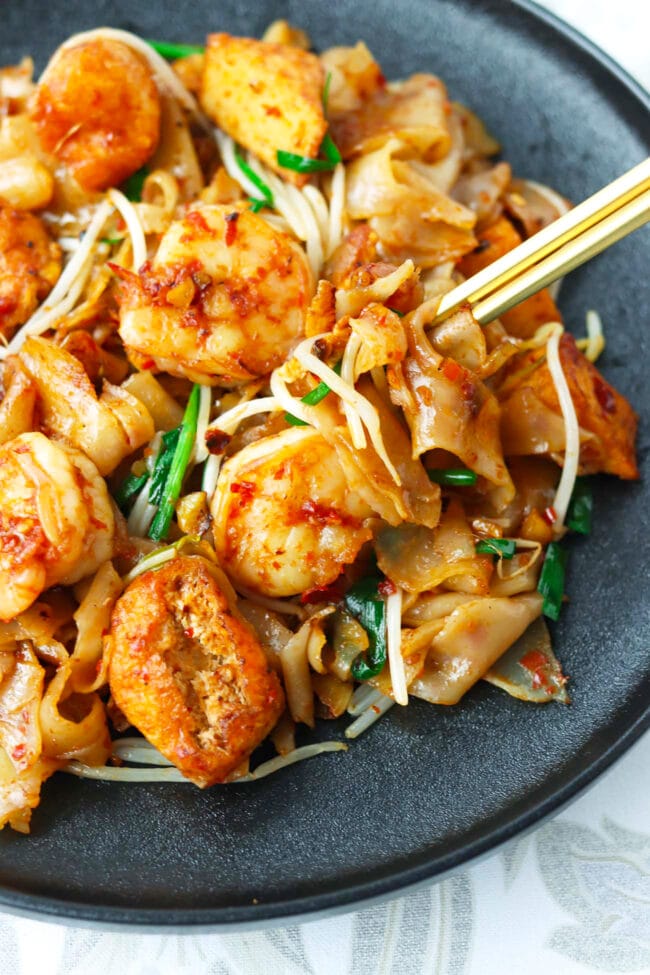
Why This Recipe Works
- Easy. Although there’s a bit of ingredients prep work involved, the actual stir-fry noodles dish is super quick to make and ready in under 10 minutes!
- DELICIOUS flavors and textures. It’s perfectly balanced with savory-sweet and spicy notes. This noodles dish also boasts lovely contrasting textures from the juicy and soft proteins, chewy charred rice noodles, and crisp mung bean sprouts!
- Wonderful charry flavor. Cooking over high heat in a properly seasoned wok delivers the signature ‘wok hei’ flavors and an enticing aroma to this dish.
- Customizable protein. You can use chicken, pork, beef, tofu, shrimp or any other seafood you love!
- Adjustable spice level. Make this dish as mild or spicy as you like by adjusting the amount of chili paste you use.
Ingredient Notes and Substitutes

Traditional char kway teow is cooked with a chili paste made of blended dried chilies – chili or ‘cili boh’. You can either use a store-bought dried chili paste purchased from an Asian supermarket or make your own homemade chili paste like I’ve done for this recipe.
If making your own, you’ll need four types of chilies – large dried red chilies, small hot dried red chilies (Bird’s Eye, Thai Jinda dried chilies, or any other type), a large fresh red chili, and small hot fresh chilies (Bird’s Eye or any other type). You’ll also need a few small Asian red shallots, and oil to sauté the paste once blended. Look for all of these in an Asian supermarket, wet market (if you’re based in Asia), or a Thai or Chinese specialty ingredients groceries shop.
Note that the large dried and fresh chilies are milder than their smaller counterparts. If you’re not too big on heat, you can leave out the small hot fresh chilies.
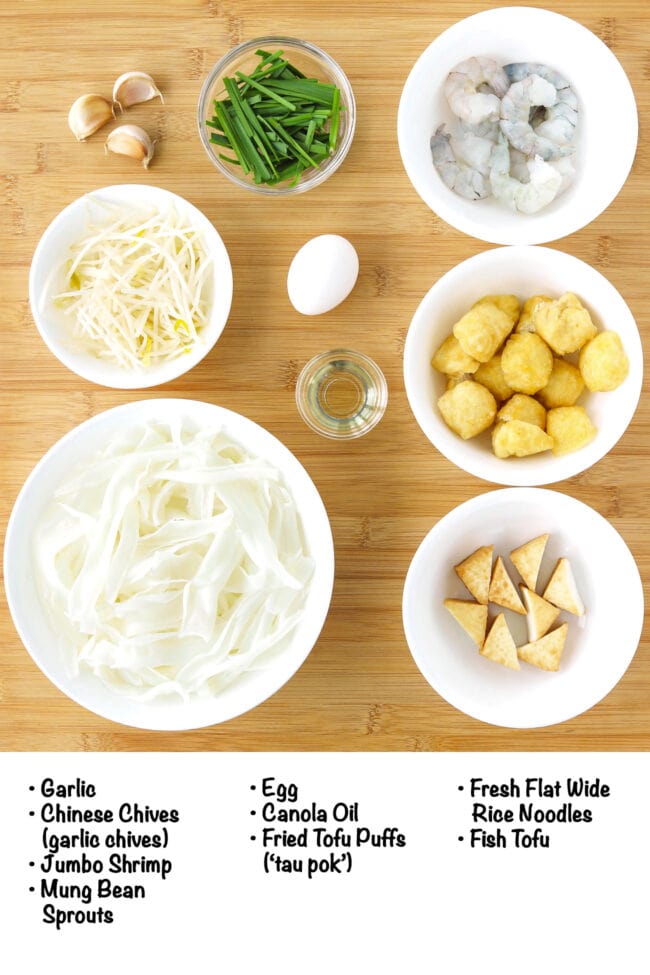
- Chinese Chives. Also known as garlic chives. These are flat chives, not round and they have a garlicky flavor. They can be found in Asian supermarkets outside of Asia and in wet markets if you’re based in Asia. Substitute with spring onion (scallion/green onion) if unavailable.
- Fresh Flat Wide Rice Noodles: Look for these in the fridge section of an Asian supermarket or at a specialty noodles shop. It’s best if you can get them from a noodles store where they haven’t been refrigerated yet. They tend to dry out in the fridge and become more difficult to work with and separate. You can purchase them in the form of noodle sheets which you can cut (or gently tear) noodle strands from. Or you can buy the pre-cut version like the ones I’ve used in my chicken chow fun. If you can’t find them, you can try making your own fresh flat wide rice noodles at home. I don’t recommend using dried rice noodles for this recipe as they simply don’t have the same chewy and bouncy texture as the fresh ones.
- Proteins: Char kway teow is typically made with blood cockles, dried Chinese sausage, and scrambled eggs in Malaysia. Since the first two might be difficult to track down where you are, I say you can customize this dish with whatever proteins you love! Traditional? No. But suited to your preference and convenient? YES all the way! I used some juicy jumbo shrimp (size 16/20 is best for the juiciest texture), fish tofu, (or you can use a sliced Asian fish cake block), fried tofu puffs (known as ‘tau pok’), and of course an egg. Fish tofu is available in cubed form in packages and they’re made of fish, not tofu. However, they have a tofu-like soft texture and appearance, hence the name. They have a wonderful salty flavor with a hint of sweetness. Fish tofu/Asian fish cake blocks and fried tofu puffs can be found in packages in the fridge section of Asian supermarkets.
- Canola Oil: Although typically made with pork lard (and you are welcome to use that instead if you prefer), I used canola oil. You can also use any type of neutral cooking oil with a high smoke point.
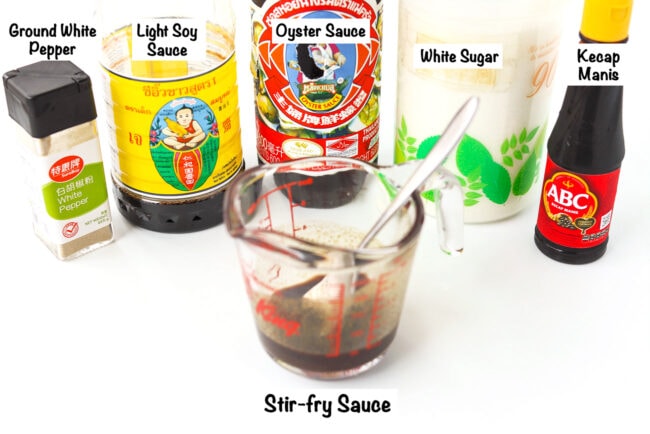
- Light Soy Sauce: Use a Thai light soy sauce which is less salty than most types of light soy sauce. Or use any type of low sodium light soy sauce.
- Kecap Manis: This is a thick and sweet Indonesian soy sauce that can be found in Asian supermarkets or Indonesian grocery stores. Substitute with Thai sweet dark soy sauce if unavailable.
- Oyster Sauce: An Asian pantry staple that you can find in most mainstream supermarkets. It’s thick and viscous in texture and has a sweet and savory flavor.
- White Pepper: For a peppery kick of heat. If you don’t have white pepper, substitute with ground black pepper.
- White Sugar: Adjust quantity to taste and use more if needed.
Full ingredient list and amounts are in the recipe card below.
How to Make Char Kway Teow
For the Chili Paste:
1. Make the chili paste. Soak the dried chilies in a bowl filled with boiling hot water for 20-30 minutes until softened. Squeeze the water out of the chilies (reserve the chili soaking water) and roughly chop. Add to a blender or food processor bowl, along with the rest of the chopped ingredients for the chili paste. Cover and pulse, adding a tablespoon or so of the chili soaking water as needed, until a smooth paste forms.
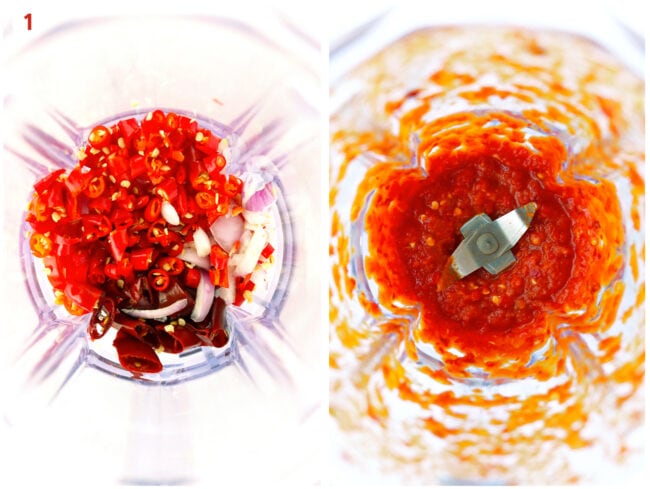
2. Fry the chili paste. Heat a little canola oil in a skillet and sauté the chili paste until slightly darkened and fragrant. Set aside while you prepare the sauce and fresh ingredients.
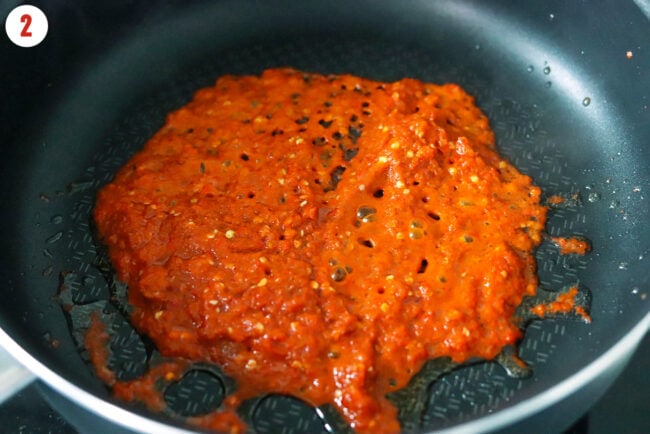
To make Char Kway Teow:
1. Stir-fry the aromatics. Stir-fry the chili paste and garlic in oil for a few seconds in large wok until fragrant.
2. Stir-fry the shrimp, fish tofu and fried tofu puffs. Just until coated with the chili paste and the shrimp is almost cooked through.
3. Cook the egg. Push everything to the side of the wok and add a little more oil to the wok. Add the egg and allow to set for a few seconds. Then break it up into pieces and toss to combine with everything.
4. Add the noodles and sauce. Stir-fry until everything is evenly coated in the sauce.
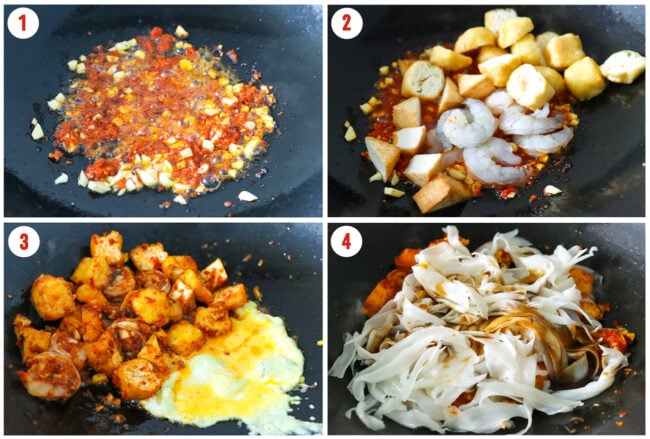
5. Toss through the mung bean sprouts and Chinese chives. Stir-fry until slightly wilted, then switch off the heat.

Serve! Divide evenly onto plates and serve immediately!

Full detailed instructions are in the recipe card below.
Cook’s Tips
- Soak the dried chilies in boiling hot water. They can be quite hard and dry so the boiling hot water will help soften them quicker than room temperature or hot water from the sink.
- Use fresh noodles and preferably non-refrigerated ones. There’ll be less noodles breakage and they taste better when they’re at their freshest. Dried flat wide rice noodles won’t do this dish justice.
- Warm noodles in the microwave if using refrigerated fresh wide rice noodles. Just briefly in increments of 20-30 seconds until they are soft and pliable enough to be separated.
- Cook over HIGH heat in a very hot wok. This will enable the noodles to char and develop the lovely “wok hei” (breath of the wok) flavor.
- Make the chili paste in advance. Make it a day or a few days in advance and store in a sealed airtight container in the fridge. This way you can prepare char kway teow in a matter of minutes for dinner or lunch on any day of the week!
- Adjust spice level to taste. Use less chili paste (about ½ – 1 tablespoon) if you prefer a milder noodles stir-fry. Store the leftover chili paste in a sealed airtight container in the fridge for up to 1 week.
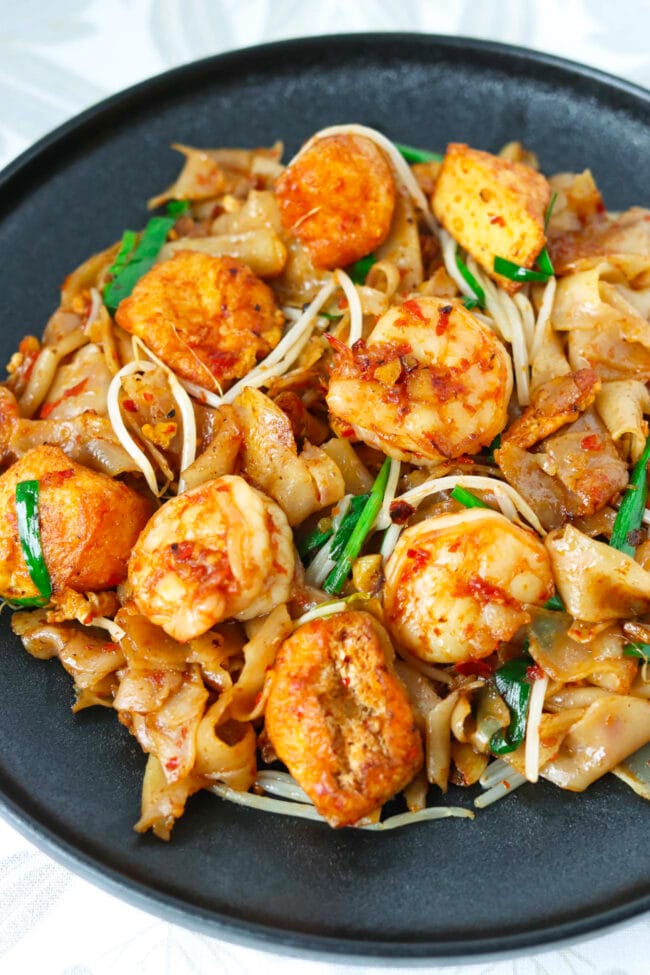
FAQs
It is typically a savory and sweet noodles dish and not excessively spicy. Some versions don’t include the chili paste in the noodles stir-fry and serve chili garlic sauce on the side. However, this version has a bit of a kick to it since it incorporates lots of the chili paste and is perfect for spice lovers!
Char means “stir-fried” and “kway teow” are the fresh flat wide rice noodles.
Use sliced boneless and skinless chicken thighs or breasts and season with kosher salt or a teaspoon of low sodium light soy sauce. Add it to the wok when you add the shrimp and other proteins (if using too).
Variations
- Customize with any protein you love. Use sliced boneless and skinless chicken thighs or breasts, pork tenderloin (fillet), beef flank or skirt steak, cuttlefish, lobster meat, squid, or just all shrimp or prawns.
- Make it vegetarian. Use a plant-based meat substitute, scrambled egg, just the fried tofu puffs or crispy pan-fried tofu cubes for the proteins. Also use a vegetarian mushroom flavored oyster sauce for the stir-fry sauce.
- Make it vegan. Same as for making it vegetarian but omit the egg.
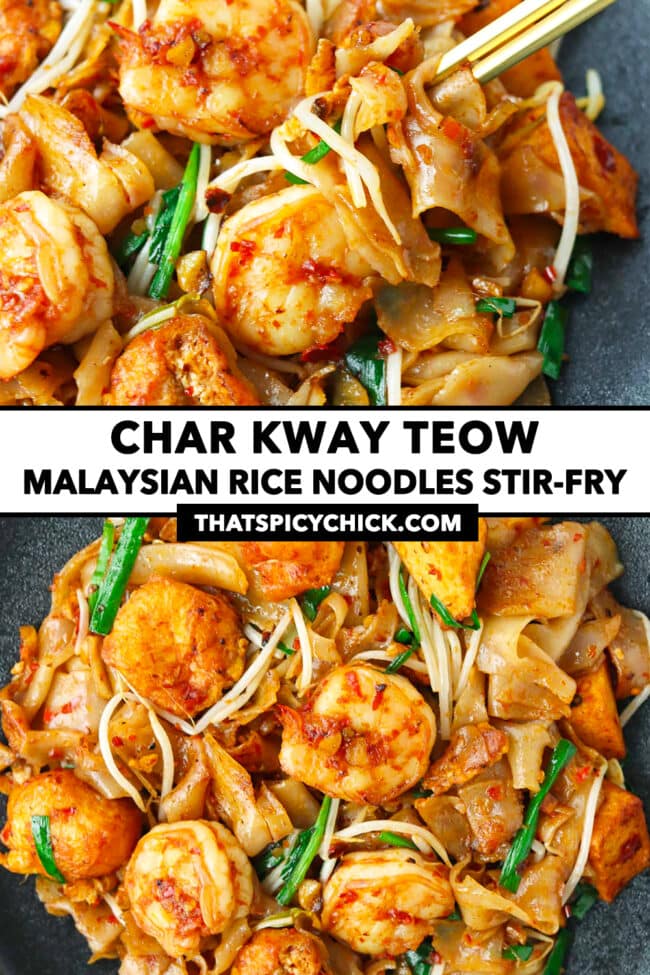
More Stir-fried Fresh Flat Wide Rice Noodle Recipes
- Thai Eggplant Noodles
- Pad Kee Mao Gai (Drunken Noodles with Chicken)
- Pad See Ew
- Thai Pork & Tomato Gravy Noodles
- Rad Na Gai (Thai Gravy Noodles with Chicken)
- Or browse the entire Noodles recipe collection.
MADE THIS RECIPE? If you make this recipe, leave a comment below and let me know how you liked it! Take a photo and tag it with @thatspicychick on Instagram and hashtag it #thatspicychick and I’ll be sure to share your masterpiece!
STAY CONNECTED! You can also follow me on Pinterest, Facebook or Instagram. Sign up for my email list to get my latest recipe in your inbox weekly!
PrintChar Kway Teow (Malaysian Flat Wide Rice Noodles Stir-fry)
Charry, smoky flat wide rice noodles, shrimp, tofu puffs, bean sprouts, and more get wok fried in a savory-sweet sauce and spicy chili paste in this EPIC Char Kway Teow dish!
- Prep Time: 30
- Cook Time: 10
- Total Time: 40 minutes
- Yield: 2 1x
- Category: Dinner
- Method: Stir-fry
- Cuisine: Malaysian
Ingredients
For the Chili Paste (note 1):
- 2 large Dried Red Chilies – soaked in a bowl of hot water, then squeezed and chopped (reserve the chili soaking water)
- 2 small Thai Jinda Dried Chilies (or Bird’s Eye Dried Red Chilies) – soaked in a bowl of hot water, then squeezed and chopped
- 1 large fresh Red Chili – chopped
- 1 – 8 fresh Thai Bird’s Eye Chilies (optional – or use any other small hot fresh red chilies) – chopped
- 2 small Asian Red Shallots (or substitute with 1/8 medium red onion) – peeled, chopped
- 1 TBLS Canola Oil (or vegetable oil), for cooking
For the Sauce:
- 2 TBLS Light Soy Sauce (Thai light soy sauce or other brand low sodium light soy sauce)
- ½ TBLS Kecap Manis (note 2)
- 1 TBLS Oyster Sauce
- ½ TSP ground White Pepper
- ¼ – ½ TSP White Sugar, to taste
For the Char Kway Teow:
- 6 Garlic cloves – roughly chopped
- 3 stalks Chinese Chives (also known as garlic chives, substitute with spring onion) – chopped into 1-inch pieces
- 1 cup Mung Bean Sprouts – rinsed, drained
- 350 grams / 12.5 ounces fresh Flat Wide Rice Noodles (note 3)
- 100 grams / 3.5 ounces peeled and deveined Jumbo Shrimp (or prawns – size 16/20 preferred)
- 50 grams / 1.75 ounces Fish Tofu (or sliced Asian fish cake from a block) – pat-dried, sliced diagonally in half
- 60 grams / 2 ounces (about 5–6 pieces) Fried Tofu Puffs (‘tau pok’) – halved
- 1 large Egg – lightly beaten in a bowl
- 3.5 TBLS Canola Oil
Instructions
Prep:
- Make the chili paste: Soak the large dried chilies and dried Jinda or Bird’s Eye red chilies in a bowl filled with boiling hot water for 20-30 minutes until softened. Squeeze the water out of the chilies (reserve the chili soaking water) and roughly chop. Add to a blender jug or food processor bowl. Chop the large fresh red chili, fresh Thai Bird’s Eye red chilies (if using), Asian red shallots and add to the blender as well. Cover and pulse until a smooth paste forms. (Note: Uncover to push down the ingredients with a spoon in between as needed. Add a tablespoon or so of the chili soaking water to help the paste come along.)
- Fry the chili paste: Heat 1 tablespoon canola oil to a skillet over medium heat. Add the chili paste and sauté for 2-3 minutes until slightly roasted and fragrant. Transfer to a clean bowl and set aside.
- Make the sauce: Whisk together the light soy sauce, kecap manis, oyster sauce, ground white pepper and white sugar in a small measuring cup (for easier pouring) or bowl until thoroughly combined and set aside.
- Prepare the fresh ingredients: Chop the garlic and Chinese chives as indicated in the ‘Ingredients’ section. Place the mung bean sprouts in a fine mesh strainer and run cold water from the sink on top and rinse. Set aside to drain. Cut the fresh noodles (if using noodle sheets and not pre-cut noodles) into 1-inch wide strands. Rinse and pat-dry the shrimp. Pat-dry the fish tofu and slice diagonally into half. Halve the fried tofu puffs. Crack the egg into a small bowl and lightly beat.
For the Char Kway Teow:
- Stir-fry the aromatics: Heat 3 tablespoons canola oil in a large wok over high heat. Once hot, add the chili paste (use ½ – 1 tablespoon only for a milder dish) and garlic. Stir-fry for 30 seconds until fragrant.
- Add the proteins: Add the shrimp, fish tofu and fried tofu puffs. Stir-fry for 1 minute, until the shrimp start to turn pink and are almost cooked through.
- Cook the egg: Push everything to the side of the wok and add the remaining ½ tablespoon of oil. Pour in the egg and allow to set for 20-30 seconds. Then break the egg up into small pieces and toss to combine with everything.
- Add the noodles and sauce: Add the rice noodles and pour the sauce on top. Stir-fry until everything is evenly coated in the sauce.
- Toss through veggies: Add the mung bean sprouts and Chinese chives. Stir-fry for 20-30 seconds until slightly wilted. Switch off the heat.
- To Serve: Divide evenly into bowls/plates or transfer to a serving plate. Serve immediately.
Notes
- Chili Paste: Traditional char kway teow is cooked with a chili paste made of blended dried chilies – chili or ‘cili boh’. You can either use a store-bought dried chili paste purchased from an Asian supermarket or make your own. If making your own and following my recipe, all the chili paste ingredients can be found in an Asian supermarket, wet market (if you’re based in Asia), or a Thai or Chinese specialty ingredients groceries shop. Note that the large dried and fresh chilies are milder than their smaller counterparts. If you’re not big on heat, leave out the small hot fresh red chilies.
- Kecap Manis: This is a thick and sweet Indonesian soy sauce that can be found in Asian supermarkets or Indonesian grocery stores. Substitute with Thai sweet dark soy sauce if unavailable.
- Fresh Flat Wide Rice Noodles: Look for these in the fridge section of an Asian supermarket or at a specialty noodles shop. It’s best if you can get them from a noodles store where they haven’t been refrigerated yet. They tend to dry out in the fridge and become more difficult to work with and separate. You can purchase them in the form of noodle sheets which you can cut (or gently tear) noodle strands from. Or you can buy the pre-cut version. If you can’t find them, you can try making your own fresh flat wide rice noodles at home. I don’t recommend using dried rice noodles for this recipe. They don’t have the same chewy and bouncy texture as their fresh counterpart and won’t do this dish justice.
- Proteins: Char kway teow is typically made with shrimp/prawns, blood cockles, dried Chinese sausage and scrambled eggs in Malaysia. Since blood cockles and Chinese dried sausage (‘lap cheong’) be difficult to track down where you are, you can customize this dish with any protein you love (see ‘Variations’ section in post). Fish tofu is available in cubed form in packages. They are made of fish, not tofu, and have a soft tofu-like texture and appearance. Fish tofu/Asian fish cake blocks and fried tofu puffs (‘tau pok’) can be found in packages in the fridge section of Asian supermarkets.
- Adjust spice level to taste. Feel free to use less chili paste (about ½ – 1 tablespoon) if you prefer a milder noodles stir-fry. You can make the chili paste a few days in advance. Store in a sealed airtight container in the fridge for up to 1 week.
Nutrition
- Serving Size: 1 plate
- Calories: 655
- Sugar: 24g
- Sodium: 752.8mg
- Fat: 32.4g
- Saturated Fat: 7.1g
- Unsaturated Fat: 21.6g
- Trans Fat: 0.1g
- Carbohydrates: 74.3g
- Fiber: 12.4g
- Protein: 24.6g
- Cholesterol: 118.6mg
This post may contain affiliate links. We are a part of the Amazon Services LLC Associates Program, an affiliate advertising program designed to provide a means for us to earn a small commission (at no extra cost to you) by linking to Amazon.com and affiliated sites. The nutritional information provided is approximate and can vary based on several factors. It should only be used as a general guideline. For more information, please see our Disclosure.


